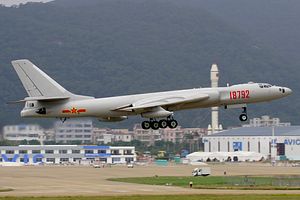The People’s Liberation Army Air Force (PLAAF) has extended its all-weather, long-range precision strike capabilities, according to a PLAAF aviation expert quoted in China Daily.
“The fact that our H-6K bombers have performed several long-distance drills far into the Pacific Ocean indicates that the H-6K fleet has become capable of conducting various operations such as long-range precision strikes,” Fu Qianshao, a PLAAF aviation equipment expert, told the state-run newspaper.
The H-6K is a derivative of the Soviet-era Tupolov Tu-16 twin-engined jet strategic bomber. However, the latest Chinese version of the bomber, first flown in 2007, has undergone major upgrades including new fuel efficient D-30-KP2 turbofans, lighter weight composites, and modern electronics.
Without refueling, the maximum range of the H-6K bomber is 1,900 miles; however, it can be extended to 3,100 miles with two mid-air refuels, according to War is Boring, while carrying a payload of up to 12 tons. There are currently around 36 H-6K strategic bombers in service with the PLAAF.
“In the past, our bombers could only deliver airdropped bombs and so were unable to conduct precision attacks, but the H-6K, with the adoption of some of our most advanced aeronautic technologies, is able to carry and launch air-to-surface cruise missiles and anti-ship missiles, which means it can take out multiple targets on the ground or at sea within one mission,” Fu stated.
The H-6K, which lacks stealth capacity, can carry up to seven YJ-12 supersonic anti-ship missiles (six on wing pylons plus one in the bomb bay) or CJ-20 subsonic land-attack cruise missiles with an estimated range of 250 and 1,500 miles respectively. “It can also carry a wide range of new precision-guided munitions available from four Chinese weapon manufacturers,” according to IHS Jane’s Defense Weekly.
“The PLA has defined its air force as a strategic force and pledged to obtain offensive capability for it. An air force with strategic aspirations must be able to perform long-range precision strike operations, so the H-6K is undoubtedly a valuable asset to the PLA Air Force,” Fu added.
Fu, furthermore pointed out that during recent military exercises the H-6K overcame “enemy defense” and “the enemy’s electromagnetic blockage.” The principal weakness, according to some military analysts, remains the targeting system of the H-6K, as well as the PLAAF’s overall targeting acquisition network.
While sporting a modern air-to-ground radar in the its large solid nose as well as a new electro-optical targeting pod, it remains unclear whether the H-6K (or the PLAAF as a whole) has the ability to collect accurate targeting information and process it quickly enough for bombing raids far away from the Chinese coast.

































